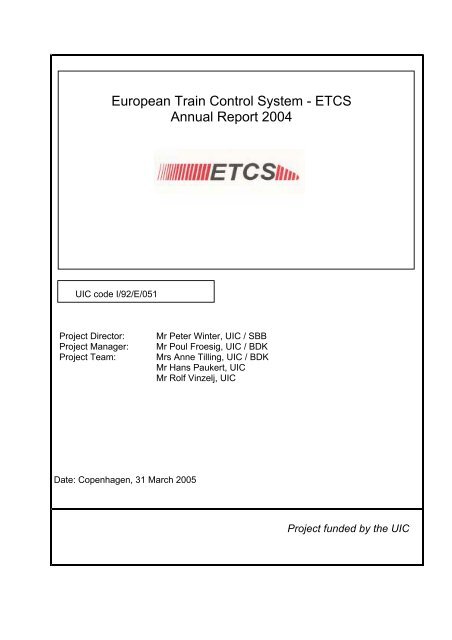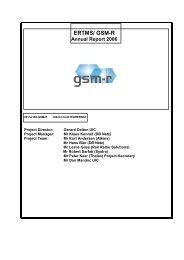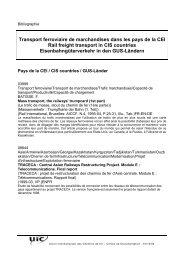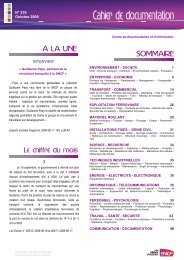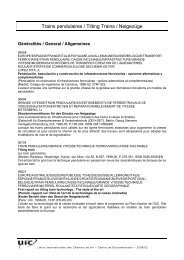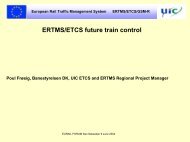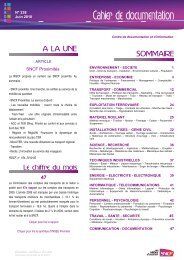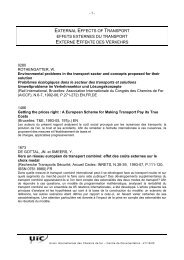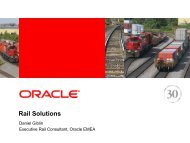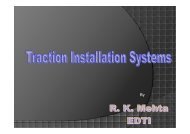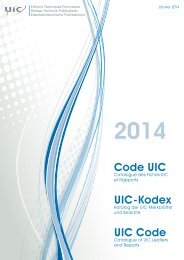UIC Project Annual Report - ERTMS
UIC Project Annual Report - ERTMS
UIC Project Annual Report - ERTMS
- No tags were found...
You also want an ePaper? Increase the reach of your titles
YUMPU automatically turns print PDFs into web optimized ePapers that Google loves.
European Train Control System - ETCS<strong>Annual</strong> <strong>Report</strong> 2004<strong>UIC</strong> code I/92/E/051<strong>Project</strong> Director:<strong>Project</strong> Manager:<strong>Project</strong> Team:Mr Peter Winter, <strong>UIC</strong> / SBBMr Poul Froesig, <strong>UIC</strong> / BDKMrs Anne Tilling, <strong>UIC</strong> / BDKMr Hans Paukert, <strong>UIC</strong>Mr Rolf Vinzelj, <strong>UIC</strong>Date: Copenhagen, 31 March 2005<strong>Project</strong> funded by the <strong>UIC</strong>
ETCS<strong>UIC</strong> code: I/92/E/051<strong>Annual</strong> <strong>Report</strong> 2004 DOCUMENT CODIFICATION REV. PAGEC 2 of 21<strong>Annual</strong> <strong>Report</strong>2004<strong>Project</strong> titleETCSCBCopenhagen31/3/2005Copenhagen28/2/2004Final versionDraftMR. P. FROESIGMR. P. FROESIGMANAGEMENT/STEERINGCOMMITTEEMANAGEMENT/STEERINGCOMMITTEEREV. DATE DESCRIPTION DRAWN UP APPROVED
ETCS<strong>UIC</strong> code: I/92/E/051<strong>Annual</strong> <strong>Report</strong> 2004 DOCUMENT CODIFICATION REV. PAGEC 3 of 21Table of ContentsTABLE OF CONTENTS 31 SUMMARY PAGE 51.1 INTRODUCTION 52 STATUS AND ACHIEVEMENTS DURING THE YEAR 2004 52.1 ETCS MIGRATION STRATEGY FOR EUROPEAN RAIL CORRIDORS 52.2 SUPPORT TO THE FINALIZATION OF TSI CONTROL COMMAND (CCS) FOR CONVENTIONALRAIL 62.3 ACTIVITIES OF THE ETCS PROJECT TEAM 72.3.1. ETCS VARIABLES 72.3.2. MATHEMATICAL BRAKING MODEL AND THE SERVICE BRAKE APPLICATION 72.3.3. SAFETY MARGINS 82.3.4. OUTSTANDING MATTERS TO BE SOLVED VERY URGENTLY 82.3.5. FEASIBILITY STUDY FOR A GUIDELINE FOR ETCS IMPLEMENTATION 92.3.6. FEASIBILITY STUDY FOR A GUIDELINE FOR ETCS EDUCATION 92.3.7. ACTIVITIES ON CORRIDOR IV AND CORRIDOR X 92.3.8 ETCS OPERATIONAL SIMULATION AT ÖBB AND CFR 112.3.9 SUPPORT TO THE AEIF CHANGE REQUEST ORGANISATION 113 ACTIVITIES PLANNED IN 2005 133.1 ETCS HANDBOOK 133.2 CAPACITY STUDY ÖBB AND CFR 133.3 FOLLOW-UP ON THE <strong>ERTMS</strong>/ETCS SPECIFICATION DEVELOPMENT 133.4 PARTICIPATION IN THE TSI CCS WORK 133.5 PARTICIPATION IN THE AEIF CCB WORK 133.6 CORRIDOR IV AND CORRIDOR X 14
ETCS<strong>UIC</strong> code I/92/E/051<strong>Annual</strong> <strong>Report</strong> 2004 DOCUMENT CODIFICATION REV. PAGEC 4 of 213.6.1 EXPECTATIONS FOR CORRIDOR IV (MAV AND CFR PART) 143.6.2 EXPECTATIONS FOR CORRIDOR X (SZ, HŽ, ŽTP BELGRADE, NRIC PARTS) 143.6.3 ACTIVITIES IN NRIC – BULGARIA 143.7 BRAKING 153.8 EUROPEAN RAILWAY INFRASTRUCTURE MASTERPLAN (CCS PART) 154 MANAGEMENT AND CO-ORDINATION ASPECTS 165 LIST OF DELIVERABLES 2004 166 LIST OF THE <strong>UIC</strong> STEERING GROUP MEETINGS HELD 17ANNEX - MS PROJECT PLANNING 17
ETCS<strong>UIC</strong> code I/92/E/051<strong>Annual</strong> <strong>Report</strong> 2004 DOCUMENT CODIFICATION REV. PAGEC 5 of 211 Summary page1.1 IntroductionThe ETCS project aims at supporting <strong>UIC</strong> member Railway administrations in their planning orrealisation of ETCS applications. With the new structure of <strong>UIC</strong>, ETCS has become a commoninterest project, part of the Interoperability - <strong>ERTMS</strong> programme.The main focus of the work in 2004 was in the following areas: The elaboration of ETCSmigration strategies on corridors including cost/benefit analysis, support for the AEIFConventional Rail TSI CCS working group (e.g. the list of open points and the <strong>ERTMS</strong>Regional explanatory document), support for the AEIF Change Request organisation, ensuringand supporting that functions relevant for the Conventional Rail system was recognised asimportant functions such as infill in level 1, awakening on loops in level 1, level crossings, and atpresent, work is carried out to establish a good platform for the introduction of the new modeLimited Supervision, organizational work on the ETCS variables, work on the braking projectphase 3, support to the <strong>ERTMS</strong> implementation on corridors in Central Europe as well as ahandbook for implementation.2 Status and achievements during the year 20042.1 ETCS migration strategy for European Rail corridorsA cost/benefit analysis (document “ETCS migration strategies on corridors and at national level– cost/ benefit analysis”) has been elaborated by P. De Cicco on the 10 international railcorridors which have been described in the report “Implementing the European Train controlSystem – Opportunities for European rail Corridors” (Dec. 2003). These corridors representapproximately 20 % of the TEN network. The costs and benefits arising from different migrationstrategies towards ETCS are presented for each of the corridors. Costs and benefits have alsobeen determined for a more general scenario of ETCS implementation.The first information on the findings of this study was presented at the InfrastructureCommission meeting in June 2004 and was endorsed by the members. Subsequently thedocument was circulated among <strong>UIC</strong> members. The EC and the Industry were given a copy inJuly 2004 for their constructive comments.In the summer of 2004, a comparative study between the 10 <strong>UIC</strong> corridors identified andanalysed by the <strong>UIC</strong> Migration strategy Group and the TEN-T priority projects proposed by theEuropean Commission and amended with the Decision 884/2004/EC has been carried out(document: ”Implementing the European Train Control System – Corridor synthesis”). The
ETCS<strong>UIC</strong> code I/92/E/051<strong>Annual</strong> <strong>Report</strong> 2004 DOCUMENT CODIFICATION REV. PAGEC 6 of 21projects related to railways, among the 30 EC projects, fit very well with the structure of the 10<strong>UIC</strong> corridors. They can be considered as prolongation or as upgrade of existing lines or smallsegments of new lines in parallel to existing ones (e.g. base tunnels).These documents are used as input for high-level meetings between EC/TREN, UNIFE/UNISIG,<strong>UIC</strong>/CER/EIM on the ETCS implementation. There is a general trend towards a corridororientedimplementation strategy for ETCS.2.2 Support to the finalization of TSI Control Command (CCS) forConventional RailP. Frøsig has supported the development of the TSI document. During this work, several keyquestions were addressed and several topics were considered on behalf of the railadministrations: Infill in level 1, awakening on loops in level 1, level crossings.At present, on CCM level, work is carried out to establish a good platform for the introduction ofthe new mode Limited Supervision.In October, the Art. 21 committee will be asked by the EU to approve the TSI document forControl Command and Signalling. The accompanying report on the TSI CCS document gives agood description of the problems discussed during the elaboration of the TSI documents. Theessential open points can be grouped in 4 categories:1) Coordination with other TSI documents e.g. Operation and Rolling stock.2) Open points in the functional specifications and relevant change requests in progress.3) Outstanding technical specifications.4) Additional specification work in order to encourage the open market.This accompanying report does not have any legal validity. It was therefore agreed at the TSICCS meeting to have the open points listed together with a short description in the TSI itself in anew annex G.Regarding the above point 4, a DB proposal has been submitted regarding which interfacesshould be further developed (the white box approach).The elaboration of chapter 7 which is dealing with the implementation has been a long anddifficult process with different versions presented for discussion.The CCS document was approved by the Member States 23 November 2004
ETCS<strong>UIC</strong> code I/92/E/051<strong>Annual</strong> <strong>Report</strong> 2004 DOCUMENT CODIFICATION REV. PAGEC 7 of 212.3 Activities of the ETCS project team2.3.1. ETCS VariablesThe allocation of values to the variables NID C, NID engine, NID STM and NID X User isongoing (responsibility of <strong>UIC</strong>, as agreed with AEIF). The latest version of the ETCS variablesdocument has been uploaded on the <strong>UIC</strong> web site (direct link from the AEIF web site also) on 7June 2004. For the NID STM, a draft proposal elaborated by UNISIG is published in August2004. The EEIG and UNISIG are still working on this document; a publishing is planned forspring 2005.For the NC Diff and NC Train, a draft proposal elaborated by <strong>UIC</strong>/AEIF specialists has beenpublished and the TSI groups Infrastructure and Rolling Stock are to give comments or suggestamendments to the proposal in order to obtain a version which is so stable that it can beuploaded and used in the coding of the balises. UNISIG is also asked to give comments on thisproposal.As to the NID Q Text, the rules writing group will draft a first proposal when the overview isestablished.For the variables M Loading Gauge and M Traction, the AEIF has drafted an initial paper to bediscussed in the respective TSI groups.2.3.2. Mathematical braking model and the service brake applicationThe project team working on ERRI WP B 126.15 has been tasked with the development andtesting of a mathematical braking model.The "Presciani" group of braking experts has proposed one common model for modelling curves"instantaneous deceleration versus speed" for mixed trains and based on the commonly usedmethod for braked- weight calculation. This model has been presented to the <strong>UIC</strong> BrakingSteering group. For certain train configurations, the available base of test data to verify themodel was insufficient; therefore additional tests had to be performed between July andSeptember 04. Some administrations have claimed that the braking algorithms are toopessimistic, and that a review of the work carried out so far is needed. On this behalf it wasdecided that the algorithm would be introduced into the TSI as a basic model for all trainconfiguration for which train length and λ-value and brake position are the only parametersavailable. For train configurations with more detailed knowledge about their braking equipment(e.g. disc brakes, electromagnetic track brakes, brake accelerators etc.) the Working Group willtry to create specific models which will generate deceleration curves that will follow moreaccurate the actual deceleration of the train and so improve line capacity.Due to the fact that the service brake application was an open point, it was only defined asoptional in the UNISIG SRS specification, and the so-called feedback from the braking systemto the ETCS system was not specified at all, it was requested at the last <strong>UIC</strong> braking steeringgroup meeting in December to clarify these two topics.
ETCS<strong>UIC</strong> code I/92/E/051<strong>Annual</strong> <strong>Report</strong> 2004 DOCUMENT CODIFICATION REV. PAGEC 8 of 21It is essential that the braking model is tested in one or more countries with trains where theETCS computer has been reprogrammed and that the trackside coding of the balises has beenverified regarding the relevant distances on the lines where the ETCS braking tests shall beexecuted. For a level 1 application, this is a very important exercise for being able to judge theinfluence of the present line side signals regarding the distance between the signals, themaximum speed obtainable, the need for infill (balise or loop) including the cables installed inaddition for this infill function.The next update of the ETCS FRS and SRS should include the updated algorithms for braking.This update is planned for the spring of 2005. Therefore, it is strongly recommended and veryimportant that such ETCS overall system tests are carried out very soon. It is essential that thewhole ETCS braking system is tested in order to gain experience with the warning curve,service braking behaviour, the driver behaviour etc.2.3.3. Safety marginsSpecial attention must be drawn to the safety margins as they will have influence on this targetfinalising the braking algorithm on the FRS/SRS level. Therefore, ERRI WP B 126.15 is alsobusy with the establishment of standardized safety margins within the ETCS system based on aprobabilistic approach and a risk evaluation. Initially, and by now only dealing with high-speedtrains at different railways, an interim technical document containing safety margins and serviceregulations has been elaborated by the Working Party. It was further agreed at the <strong>UIC</strong> Brakingsteering group meeting on 2 July 04 that the Independent Safety Assessment (ISA) should beinvolved at once in order to speed up the process. At the <strong>UIC</strong> Braking steering group meeting 8December it was recommended to introduce a national value in a transition phase, so that thecountries who have a need for introducing ETCS on their conventional rail system could haveoptions to have a workable method introduced in the ETCS system in order to avoid getting intoa conflict with their present signalling system. The group, supported by the University ofFlorence, is currently defining a common safety target and perform a risk analysis (usingstatistical methods) for different types of trains to compare the actual situation with a futuresafety target.2.3.4. Outstanding matters to be solved very urgentlyAt present, the following topics are outstanding and need urgent clarification:- the introduction of the service brake application in the rolling stock vehicles;- the introduction of the feedback from the air system to the ETCS onboard in relation tothe service brake application;- the introduction of a new wording in chapter 7 of the TSI CCS allowing a member stateto reject a train that does not have any service brake application installed;- the introduction of a national value for the safety margin in the braking algorithms;- finalisation of the ETCS FRS and SRS specifications taking the above points intoconsideration;- development of specific braking models for certain train categories to improve linecapacity.
ETCS<strong>UIC</strong> code I/92/E/051<strong>Annual</strong> <strong>Report</strong> 2004 DOCUMENT CODIFICATION REV. PAGEC 9 of 212.3.5. Feasibility study for a guideline for ETCS implementationIt was originally planned that the handbook for implementation should have been finalised bythe end of 2004. Due to serious illness of the key person in question, the handbook will bedelayed for some months. It is the aim to test the contents of the handbook for a level 1application in connection with the planning and execution of the CFR part of the ETCS projecton Corridor IV. A level 2 application should be selected for tests in a similar way.2.3.6. Feasibility study for a guideline for ETCS educationThis study aims to focus on the education needed especially at the driver’s level, which is veryimportant for the success of the ETCS system. We are still looking for a candidate withoperational experience to be the leader of this study.2.3.7. Activities on Corridor IV and Corridor X2.3.7.1 Status for the CFR part of Corridor IV (Bekescsaba – Arad, MAV-CFR)CFR and the ETCS project have investigated several aspects of possible ETCS implementationscenarios for the CFR network. One specific application of interest for several countries wasspecifically looked at as CFR has today all signals equipped with the “old” INDUSI 60, includingmany 500 Hz INDUSI magnets. The onboard functionality of reading the 500 Hz magnet is onebasic difference between the “Old” I 60 version and the updated PZB 90 version of the INDUSIsystem which is in operation e.g. at DB. As many countries in this Central European regionhave the I 60 version of INDUSI in service, <strong>UIC</strong> considered together with some of the concernedrail administrations on corridor IV and X that a transition from the INDUSI I 60 system via the newmode ETCS LS (Limited Supervision) towards an ETCS level 1 application could be aninteresting topic to have analysed. Several scenarios identifying different applications areavailable.<strong>UIC</strong> has also been supporting the elaboration of the call for offer document for the Romanianpart of Corridor IV using and testing the new <strong>UIC</strong> template for call for offer documents.2.3.7.2 Status for Corridor X activities performed in 2004In February, a first co-ordination meeting for Corridor IV and X Railways together with theindustry was held in Vienna.The aim of the meeting was to continue the work on the Corridors based on the distributedproposal. The <strong>UIC</strong> has also provided a ''Common Template for Call for Offers''. The transitionfrom INDUSI towards ETCS was discussed.On 28 and 29 Aprilin Belgrade, a presentation of the implementation of the <strong>ERTMS</strong>/ETCSsystem on Corridor X was held with the purpose to make signal and traffic engineers familiarwith the system.
ETCS<strong>UIC</strong> code I/92/E/051<strong>Annual</strong> <strong>Report</strong> 2004 DOCUMENT CODIFICATION REV. PAGEC 10 of 21The agreements for ''Loan of staff'' between <strong>UIC</strong>, SŽ, ZPD d.d., ŽTP Belgrade, NRIC and MAVwere prepared according to the <strong>UIC</strong> template together with annexes for all Cross-border studieswith Slovenia, Croatia, Bulgaria, Hungary and the Belgrade - Bar line.Comparative scenarios were made at the pilot station (Kukujevci-Erdevik) for the existingsystem INDUSI-I60 and the ETCS system that show ''improvement possibility'' of ETCS LS onthe station as well as the open line.On 3 and 4 May, an expert meeting was held in Zagreb in context with the common activities forimplementing the ETCS system on Corridor X.The other two workshops were held in Zagreb with the following topics:- The FRS for the ETCS system was explained.- The scenarios for 4 stations in the cross-border section with ŽTP Belgrade on theBelgrade - Zagreb line were elaborated.- The FRS had been translated into the corresponding national language and prepared forthe workshop.- The board of HŽ (the Croatian Railways) gave its approval of the ''Railway <strong>Project</strong>community Zagreb'' for cooperation on the ETCS project with <strong>UIC</strong> and set up a workingteam for this project.The Slovenian Ministry for Transport made a feasibility study together with Holland Rail Consultabout the implementation of the <strong>ERTMS</strong>/ETCS system on the Slovenian railways. The studytreated all important reconstruction on the signal-safety equipment for the implementation of theETCS system.All Layout plans with scenarios and truth-tables with LEU connections on the line Zidani Most –Dobava - Zagreb were drafted, and <strong>UIC</strong> will comment on the documents concerned in cooperationwith the railways.The Bulgarian Railways and ŽTP Belgrade agreed upon the cross-border section on the lineNiš-Sofia. The four stations on the Bulgarian part and three stations on the Serbian-Montenegrin side were evolved into pilot sections.Up till now, only a principle agreement about the cross-border section on the Hungarian –Serbian-Montenegrin border on the Belgrade - Budapest line was obtained.The implementation of ETCS on this line has been postponed due to political elections.On 30 September, the <strong>ERTMS</strong>/ETCS meeting for Corridor X Railways was held in Zagreb.The aim of the meeting was to accelerate ETCS activities on Corridor X and to analyse theprincipal problems.On 22 December, the director general of ŽTP Belgrade signed the ETCS Agreements governingsecondment between <strong>UIC</strong> and ŽTP Belgrade.
ETCS<strong>UIC</strong> code I/92/E/051<strong>Annual</strong> <strong>Report</strong> 2004 DOCUMENT CODIFICATION REV. PAGEC 11 of 212.3.8 ETCS operational simulation at ÖBB and CFRTogether with the University of Aachen, ÖBB and CFR, a study on this topic is carried out. Theuniversity already has a simulation tool for LZB and PZB, so the first action will be to update thistool with the ETCS characteristics for Level 1 with and without infill, and for Level 2.It is the aim of the study to have a report available that documents the differences in e.g.capacity on a line with INDUSI I 60, INDUSI PZB 90, ETCS level 1 and ETCS level 1 with infill.At present, data is collected for the study of the selected parts of the lines Vienna – Salzburgand Wels - Passau, as well as a section of Corridor IV in Romania.A first draft report is expected by the middle of 2005.2.3.9 Support to the AEIF change request organisation2.3.9.1 Future FRS 4.29 review to be organizedDuring the AEIF CCB meetings, the <strong>ERTMS</strong> Users Group has proposed the establishment of areview of the FRS 4.29, so that it conforms to the UNISIG SRS 3.0.0. Beyond this review, thereis a need for an FRS document covering the functions needed for the Conventional Rail andwhere the functions needed for this operation are introduced as mandatory in the FRS inaccordance with recognised change requests. The general comments elaborated in 2002 by theTSI FRS ad hoc group should also be considered.At present, the <strong>ERTMS</strong> Users Group is analysing the economical impact of such a review.This next version of the FRS will be conform to the next SRS Version 3.0.0 and also cover thefunctions needed for the conventional rail network. This version of the FRS should be availableand referenced in the TSI CCS Annex A by the middle of 2005. <strong>UIC</strong> will deliver an input to thisreview. Preparatory work has been initialised in 2004 on this topic e.g. by considering the FRSfor the new mode limited supervision.2.3.9.2 Euroloop (Infill by cable)ÖBB, <strong>UIC</strong> and EEIG arranged a meeting including a trip on the ÖBB ETCS line in May 2004.It was demonstrated during the trip that the level 1 infill function is needed for capacity as wellas for safety reasons. EEIG chaired the meeting where the future infill users were invited fromthe railways as well as the UNISIG Companies. ÖBB stated clearly that it needs a stablesituation for the specifications with clear references listed in the TSI CCS Annex A due to thefact that in the near future, the ÖBB will launch a tender for the lines Vienna - Salzburg as wellas Wels – Passau. A. Colaço, J. Tamarit and P. Froesig stated clearly in common that this mustbe the aim in 2004.2.3.9.3 ETCS Level Crossing functionsTogether with the concerned Railway administrations, EEIG and PKP, the <strong>UIC</strong> ETCS projectteam has produced several explanatory scenarios to give a clear functional description of thefuture content of the SRS. At the AEIF CCB meeting 16 June, the railway requirements were
ETCS<strong>UIC</strong> code I/92/E/051<strong>Annual</strong> <strong>Report</strong> 2004 DOCUMENT CODIFICATION REV. PAGEC 12 of 21handed over to UNISIG with the request to study and comment on the proposal and have thelevel crossing function introduced in version 3.0.0 of the SRS to be referenced in Annex A of theTSI CCS. IT has been agreed at the AEIF change request level (CCB) in the summer of 2004that the level crossing functionality will be included in the next version 3.0.0. of the ETCS SRSspecification.2.3.9.4 Awakening in level 1 on EUROLOOPAt the AEIF CCB meetings in January and April 2004, the Danish autorithies introduced achange request regarding awakening in level 1 on EUROLOOPs. It was concluded that the level2 awakening problems discussed in <strong>ERTMS</strong> Users Group should be combined with the level 1problems as they are indicated in the Danish change request, so that a total awakeningphilosophy for level 1 as well as level 2 can be developed. The process is developing andscenarios and explanatory documents are under elaboration by the EEIG. The basic problemfor Denmark is that such a function is incorporated in the Danish ZUB system in operation on allDanish trains and ETCS would therefore in the awakening operation be less safe than theexisting class B system.2.3.9.5 New ETCS mode “Limited SupervisionSeveral years ago, this mode was introduced as a change request by RFF/SNCF based on anSBB proposal. It was agreed at the ETCS / ETCS-LC Steering Group meeting in the spring of2004 to arrange a workshop on this topic in order to create a better understanding for the use ofthis mode in a transition towards a full level 1 or 2. The introduction of this mode would alsoreduce the amount of different STM's onboard as the mode should be considered interoperable.Therefore, for several countries it is important to have this mode introduced in the ETCSspecifications as soon as possible, so that the planning of the transitions can be undertakenand tests can be carried out. For some central European countries who have INDUSI in servicetoday, and especially for Switzerland as a transit country, this is important. It should bementioned that CFR and the ETCS project has developed a transition from INDUSI I 60 towardsETCS for the Romanian part of the Corridor IV line. This concept could also be used for othercountries in the Balkan region.After the <strong>UIC</strong> workshop held on 30 June 2004, is was agreed that <strong>UIC</strong> should produce an FRSdocument (chapter) as the first step and as a stand-alone document, but prepared so that thischapter could be incorporated into the next version of the FRS without e.g. creating newconformity problems.In Limited Supervision mode, it shall be possible to use only the emergency brake for being ableto mirror certain existing protection systems that today only have the emergency brakeapplication. Thereby, also the use of the existing relays as input for the balise (a very simplifiedLEU SIL level 0 or 1) shall be possible.The FRS chapter has been distributed for comments to the 8 railway administrations whichwere identified at the workshop. The administrations are ÖBB, SNCB / NMBS, BDK(Banedanmark), DB, RFI, CFR, Network Rail, and SBB.
ETCS<strong>UIC</strong> code I/92/E/051<strong>Annual</strong> <strong>Report</strong> 2004 DOCUMENT CODIFICATION REV. PAGEC 13 of 21Since then, several meetings have taken place between different parties also with heavyinvolvement from UNISIG.At the time of writing, it seems that the new LS mode will be included in the next version 3.0.0.of the ETCS SRS.DB has now replaced the RFF/SNCF as owner of the change request.3 Activities planned in 2005In general, support will be given to the administrations on specific topics on request as inthe past.3.1 ETCS HandbookIt is the aim to apply the content of the handbook at a first implementation on an <strong>ERTMS</strong>/ETCSlevel 1 line at CFR. A level 2 line is proposed to be selected as well.3.2 Capacity study ÖBB and CFRIn co-operation with the University of Aachen, <strong>UIC</strong>, ÖBB and CFR, a tool will be ´finalised whichallows a comparison of capacity between lines with conventional signalling (a first stepequipped with Indusi) and lines equipped with <strong>ERTMS</strong>/ETCS level 1 with and without infill.3.3 Follow-up on the <strong>ERTMS</strong>/ETCS specification developmentThe present <strong>UIC</strong> FRS specification, version 4.29, has to be updated so that it complies with theUNISIG SRS version 3.0. Over and above, also editorial changes have to be made to avoidmisunderstandings of the remaining text. This work will be performed in co-operation with theEEIG. This new revised version shall be replace the FRS 4.29 version in the TSI Annex Adocument.3.4 Participation in the TSI CCS workThe <strong>UIC</strong> project manager will continue to participate in the TSI CCS work and from case to caseensure support and coordination among the administrations where relevant or wanted by one ora group of administrations as in the past.3.5 Participation in the AEIF CCB workThe <strong>UIC</strong> project manager will continue to participate in the AEIF change control board (CCB)work and from case to case ensure support and coordination among the administrations whererelevant or if requested by one or a group of administrations as in the past.
ETCS<strong>UIC</strong> code I/92/E/051<strong>Annual</strong> <strong>Report</strong> 2004 DOCUMENT CODIFICATION REV. PAGEC 14 of 213.6 Corridor IV and Corridor XIt has been agreed that <strong>UIC</strong> shall continue to support the establishment of <strong>ERTMS</strong> in thiscentral European Region. In general, it shall be considered if GSM-R voice will be introduced aspart of the upgrade of the operation of the concerned corridors. Special focus is put onCorridors IV and X.3.6.1 Expectations for corridor IV (MAV and CFR part)A first border-crossing meeting is planned for the middle of February between <strong>UIC</strong>, MAV, CFRand EU for the official presentation of the strategy for this line to EU, agree on the nextmilestones, the presentation of the call for offer documentation, the presentation of theimplementation and testing strategy, the presentation of the time plans etc.3.6.2 Expectations for Corridor X (SZ, HŽ, ŽTP Belgrade, NRIC parts)The Slovenian Railways plan to work on an economic analysis for the implementation of ETCSon the Zidani Most - Dobava line, and after that on a time plan for embedding the ETCS systemon this line.HŽ (the Croatian Railways) want to accomplish a Strategic Study of ETCS and GSM-Rimplementation on all corridor lines in Croatia.A meeting together with the Serbian-Montenegrin Railways is provided for in the first quarter ofthe year.Together with Institute ''Kirilo Savić'' and the Ministry for Science and Research, the Serbian-Montenegrin Railways (ŽTP Belgrade) want to make a Strategic Study of ETCS and GSM-Rimplementation on all Corridor X lines in Serbia-Montenegro.Bilateral meetings with the Croatian and the Bulgarian Railways are foreseen very soon.The intensive work on scenarios for all cross-border stations is on-going.It is evident that there is a need for one or two workshops on the topics FRS and SRS of theETCS system and to clarify some requirements.3.6.3 Activities in NRIC – BulgariaNRIC and ŽTP Belgrade agreed upon the cross-border line section. Four stations on theBulgarian and three stations on the Serbian-Montenegrin side will be included in the pilotsection. The four stations on the Bulgarian part are Kalotina zapad, Kalotina, Dradoil andDragoman. Also under consideration is the possibility that all the stations (9 in total) from theSerbian border to Sofia may be included.The electrification from Dragoman to the border is ongoing. The deadline for the completion ofconstruction and power supply was the end of 2004.For the pilot project, the requirements (functional and system) to the ETCS system will be thesame as for the present project Sofia – Plovdiv – Burgas.
3.7 BrakingETCS<strong>UIC</strong> code I/92/E/051<strong>Annual</strong> <strong>Report</strong> 2004 DOCUMENT CODIFICATION REV. PAGEC 15 of 21Finalisation of the ETCS FRS and SRS specifications taking the points mentioned above insection 2.3.5 into consideration, i.e. the definition of the revised braking algorithm for thewarning, service- and emergency brake curves as well as the definition of the warning curvewhen only the emergency brake is applied in the case where the service brake application willnot be implemented.The following reports will be delivered in 2005:• The DB test report,• The ČD test report,• A final report of the studies of the University of Florence,• A final version of B 126 DT 407,• The revised braking algorithms including all the braking aspects (Warning, service andEmergency curves. This is basically a deliverable of the EEIG, but financed by the <strong>UIC</strong>ETCS budget.It has further been decided to define safety margins per interim as “national values” which willallow Group C to continue its work.As it has been decided at the last Braking Steering Committee meeting in December 2004, bothWorking groups will continue their activities:• Group A will submit a final version of a basic model to convert λ into a speeddependent deceleration function to be introduced into the TSI at the next SteeringCommittee meeting (9 February). It shall be valid for all train configurations for whichmore detailed input parameters to use an enhanced model are not available.• Group A will further develop specific conversion models taking into account theinfluence of the brake development time and additional parameters like disk-brakedvehicles, vehicles with electromagnetic track brakes ep-brakes etc.• After having submitted the enhanced model by the middle of 2005, Group A willproduce a report containing a detailed description how the model was created,evaluated and finally improved for certain train categories.• Group C will continue its work of creating a method to use standardized safety marginsafter having defined a common safety target for all kinds of trains.• After the submission of the results, Group C will produce a report containing allinformation that led to this standardized safety model.3.8 European Railway Infrastructure Masterplan (CCS part)Fundamental to a clear perspective on <strong>ERTMS</strong>, is a good technical inventory of the currentsignalling infrastructure along the European corridors identified by <strong>UIC</strong> in consultation with CERand EIM which now are part of the TSI CCS for conventional rail and will be the starting point forthe EU deployment strategy for <strong>ERTMS</strong>.
ETCS<strong>UIC</strong> code I/92/E/051<strong>Annual</strong> <strong>Report</strong> 2004 DOCUMENT CODIFICATION REV. PAGEC 16 of 21This inventory will be carried out in 2005 in the context of other business decisions on futuretraffic and investment needs and accordingly <strong>UIC</strong> is going to co-ordinate this activity veryclosely with the wider European Railway Infrastructure Masterplan (ERIM), which will also studyoth er infrastructure investment and traffic forecasts on the same network corridors.4 Management and co-ordination aspectsThe <strong>ERTMS</strong>/ETCS project will coordinate the activities with the AEIF CCS, CCM, CCSC andCCB organisation (the AEIF change request organisation) and other relevant projects inside theIntegrated <strong>ERTMS</strong> projects, especially EURO-interlocking, but also GSM-R work will beensured.5 List of Deliverables 2004Basic deliverables of the <strong>UIC</strong> ETCS project is on one side support to the ETCS ongoingactivities by participating in meeting, preparing documents for matters to be discussed and onthe other side documents/reports which are available−−−−−−−−−−−−−Common template for call for offers.Comparison of <strong>UIC</strong> Corridor study in relation to Van Miert priority projects Participatingin the AEIF TSI CCS groupSupporting the infill Euroloop change request (ÖBB, RENFE, BDK, CFR)DB AG, BV, SZ, NetworkSupporting the Danish Authorities in corporation with the EEIG on the progressing onthe change request Awakening on Loop in level 1Limited Supervision – Final FRS and scenarios.− Documents for the <strong>ERTMS</strong> Conference – Rome, 15-17 December 2004.−<strong>Project</strong> annual report 2003.ETCS Cost/Benefit analysis.Allocation of NID C, NID Engine, NID X user, NID STM in the ETCS Assignment ofVariables document uploading on the <strong>UIC</strong> side when relevantParticipating in the AEIF CCB change control boardSupporting the level crossing change request (PKP, CD, BDK,Rail)Supporting the new mode limited supervision change request(DB AG, SBB, CFR, SNCB, BDK)ETCS status reports.Interim report on Corridor IV.Braking curves – Test report DB.
ETCS<strong>UIC</strong> code I/92/E/051<strong>Annual</strong> <strong>Report</strong> 2004 DOCUMENT CODIFICATION REV. PAGEC 17 of 21− Braking curves – Final test evaluation report.− Braking curves – Enquiry on braking safety margins – Recommendations for inputs into<strong>ERTMS</strong> braking curves (warning, service and emergency).− Safety margin – Risk factor report− Safety margin – Algorithm test case report.6 List of the <strong>UIC</strong> Steering group meetings heldThe 32 nd meeting of the ETCS Steering Group was held on 19 March 2004 in Brussels.rdThe 33 meeting of the ETCS Steering Group was held on 28 September 2004 in Paris.The agendas and/or minutes of the ETCS / ETCS-LC Steering Group meetings can be found onthe <strong>UIC</strong> ETCS web site under Meetings & Events – ETCS Steering Group meetings(http://etcs.uic.asso.fr/m_steering.html).ANNEX - MS <strong>Project</strong> Planning<strong>Project</strong>plan ver. 8.3 dated 09/10/2004.
ID Task Name Duration Start Finish1European Train Control System805 days? Thu 18/12/03 Wed 17/01/072 <strong>Project</strong> Management/Administration 793 days? Mon 05/01/04 Wed 17/01/073 <strong>Project</strong> Management 780 days Mon 05/01/04 Fri 29/12/064 Administrative, business management tasks 780 days Mon 05/01/04 Fri 29/12/065 Publicity, promotion, video and <strong>UIC</strong> website 780 days Mon 05/01/04 Fri 29/12/066 Travel expenditures 780 days Mon 05/01/04 Fri 29/12/067 Deliverable - Management <strong>Report</strong> 778 days? Mon 26/01/04 Wed 17/01/0719 Official meetings 7 days Thu 24/06/04 Fri 02/07/0422 AEIF/<strong>UIC</strong> assignment of variables 525 days Mon 05/01/04 Fri 06/01/0623 NC_DIFF NC_TRAIN (principles) 260 days Mon 05/01/04 Fri 31/12/0424 NC_DIFF NC_TRAIN (allocation) 260 days Mon 05/07/04 Fri 01/07/0525 M_LOADINGAUGE - <strong>UIC</strong> PROPOSAL is that260 days Mon 05/01/04 Fri 31/12/04principles are to be set up by AEIF TSI OP & RS26 M_LOADINGAUGE (allocation) 260 days Mon 05/01/04 Fri 31/12/0427 M_TRACTION- <strong>UIC</strong> PROPOSAL is that principlesare to be set up by AEIF TSI E & RS<strong>UIC</strong> Infrastructure CommissionIntegrated Programme: Interoperability <strong>ERTMS</strong>ETCS <strong>Project</strong>260 days Mon 05/01/04 Fri 31/12/042004 2005 2006 200O N D J F M A M J J A S O N D J F M A M J J A S O N D J F M A M J J A S O N D J F28 M_TRACTION (allocation) 260 days Mon 05/01/04 Fri 31/12/0429 Q_TEXT - principles will be elaborated by EEIG rules 260 days Mon 05/01/04 Fri 31/12/04writing group30 Q_TEXT (allocation) 260 days Tue 06/01/04 Mon 03/01/0531 M_VERSION -<strong>UIC</strong> PROPOSAL is that principles are 0 days Mon 05/01/04 Mon 05/01/04to be set up by EEIG32 M_VERSION (allocation) 0 days Mon 05/01/04 Mon 05/01/0433 NID_C; NID_ENGINE; NID_XUSER; (allocation) 525 days Mon 05/01/04 Fri 06/01/0605/0105/0134 STM - principles to be set up by <strong>UIC</strong> 525 days Mon 05/01/04 Fri 06/01/0635 STM - (allocation) 260 days Mon 05/01/04 Fri 31/12/0436 Deliverable: allocation of NID C, NID Engine, NID 1 day Mon 07/06/04 Mon 07/06/04X user, NID STM37 Deliverable: ETCS Assignment of Variables1 day Mon 27/12/04 Mon 27/12/04document38 Specific studies 522 days Thu 01/01/04 Fri 30/12/0507/0627/1239 Migration strategies on corridors and at national 513 days Wed 14/01/04 Fri 30/12/05level40 Deliverable: Cost/Benefit analysis 1 day Mon 03/05/04 Mon 03/05/0441 Deliverable: Comparison of <strong>UIC</strong> Corridor studyin relation to Van Miert priority projects1 day Mon 23/08/04 Mon 23/08/0403/0523/08Doc. Code:ETCS_PF_PdC_v08.3.mppDate: 09/10/2004TaskSplitProgressMilestoneSummary<strong>Project</strong> SummaryExternal TasksExternal MilestoneDeadlinePage 18/21
ID Task Name Duration Start Finish<strong>UIC</strong> Infrastructure CommissionIntegrated Programme: Interoperability <strong>ERTMS</strong>ETCS <strong>Project</strong>42 Deliverable: Documents for <strong>ERTMS</strong> Conference - 1 day Thu 25/11/04 Thu 25/11/04Rome, 15-17 Dec. 200443 Level Crossings - Change Request of FRS ver. 4.29 118 days Mon 05/01/04 Wed 16/06/04- CR 3744 Revew of SRS (related to Level Crossing) 132 days Thu 01/07/04 Fri 31/12/0445 INFILL 333 days Thu 01/01/04 Mon 11/04/0546 Review of Test requirement specifications - TSI 325 days Thu 01/01/04 Wed 30/03/05annex A Index 5347 Awakening on loops - CR 74 325 days Tue 13/01/04 Mon 11/04/0548 Limited Supervision - CR 25 132 days Thu 01/07/04 Fri 31/12/0449 Updating FRS 66 days Thu 01/07/04 Thu 30/09/0450 Operational scenarios 132 days Thu 01/07/04 Fri 31/12/0451 Updating FRS 4.29 132 days Thu 01/07/04 Fri 31/12/0452 Co-operation with EEIG 132 days Thu 01/07/04 Fri 31/12/0453 Deliverable: LS Final <strong>Report</strong> on FRS and1 day Thu 30/09/04 Thu 30/09/04scenarios54 Braking Curves 520 days Mon 05/01/04 Fri 30/12/0555 Phase 3 -Tests 260 days Mon 05/04/04 Fri 01/04/0556 Management 254 days Mon 05/04/04 Thu 24/03/0557 Purchase of existing results with cast iron 40 days Mon 05/04/04 Fri 28/05/042004 2005 2006 200O N D J F M A M J J A S O N D J F M A M J J A S O N D J F M A M J J A S O N D J F25/1130/09PF58 Deliverable: BC enquiry report on0 days Fri 28/05/04 Fri 28/05/04braking safety margins59 Processing of K shoes test results 45 days Tue 01/06/04 Mon 02/08/0460 Preparation of tests to validate the40 days Mon 05/04/04 Fri 28/05/04conversion models (CD, DB)61 Deliverable: test plan (CD, DB) 0 days Fri 28/05/04 Fri 28/05/0462 Performance of tests to validate the88 days Tue 01/06/04 Thu 30/09/04conversioin model (CD, DB)63 Deliverable: test report (CD, DB) 0 days Thu 30/09/04 Thu 30/09/0428/0528/0530/0964 Tests with DB AG dynamic simulator(service brake applications)128 days Mon 05/04/04 Wed 29/09/0465 Deliverable: test report (DB) 0 days Mon 25/10/04 Mon 25/10/0466 Tests with onboard equipement to verify 174 days Tue 01/06/04 Fri 28/01/05service brake curves67 Milestone: test report service brake0 days Fri 28/01/05 Fri 28/01/05curves68 Evaluation of all test results 45 days Mon 04/10/04 Fri 03/12/0425/1028/01Doc. Code:ETCS_PF_PdC_v08.3.mppDate: 09/10/2004TaskSplitProgressMilestoneSummary<strong>Project</strong> SummaryExternal TasksExternal MilestoneDeadlinePage 19/21
<strong>UIC</strong> Infrastructure CommissionIntegrated Programme: Interoperability <strong>ERTMS</strong>ETCS <strong>Project</strong>ID Task Name Duration Start Finish2004 2005 2006 200O N D J F M A M J J A S O N D J F M A M J J A S O N D J F M A M J J A S O N D J F69 Deliverable: BC Final Test evaluation 0 days Fri 03/12/04 Fri 03/12/0403/12report70 Verification of braking power build-up timefor train lengths other than those tested44 days Tue 02/11/04 Fri 31/12/0471 Milestone: test report 0 days Fri 31/12/04 Fri 31/12/0472 Verification of the deceleration model 43 days Wed 01/12/04 Fri 28/01/0573 Milestone: model verified 0 days Fri 28/01/05 Fri 28/01/0574 Simplification of the deceleration model 85 days Mon 04/10/04 Fri 28/01/0575 Milestone: parameter reduction 0 days Fri 28/01/05 Fri 28/01/0576 Final report 44 days Tue 01/02/05 Fri 01/04/0577 Deliverable: final report 0 days Fri 01/04/05 Fri 01/04/0578 Safety Margin 520 days Mon 05/01/04 Fri 30/12/0579 Methodology - Algorithm, test case240 days Mon 05/01/04 Fri 03/12/04validation80 Deliverable: SM algorithm, test case0 days Mon 13/12/04 Mon 13/12/04report81 Methodology - Safety target definition 246 days Mon 05/01/04 Mon 13/12/0482 Milestone: safety target report 0 days Mon 13/12/04 Mon 13/12/0483 Methodology - Risk Factors 260 days Mon 05/01/04 Fri 31/12/0484 Deliverable: SM risk factor report 0 days Fri 31/12/04 Fri 31/12/0485 Realisation - Determination of nominalbraking conditions86 Deliverable: nominal braking conditionsreport87 Realisation - Safety coefficient assessmentfor different operational cases255 days Mon 06/09/04 Fri 26/08/050 days Fri 26/08/05 Fri 26/08/05255 days Mon 06/09/04 Fri 26/08/0588 Milestone: safety coefficients 0 days Fri 26/08/05 Fri 26/08/0589 Drafting of a specification proposal 20 days Mon 05/09/05 Fri 30/09/0531/1228/0128/0101/0413/1213/1231/1226/0826/0890 Deliverable: draft specification 0 days Fri 30/09/05 Fri 30/09/0591 Maintenance and Operating rules 85 days Mon 05/09/05 Fri 30/12/0592 Deliverable: Maintenance and Operating 0 days Fri 30/12/05 Fri 30/12/05Rules guidelines93 Low adhesion cases 84 days Tue 06/09/05 Fri 30/12/0594 Deliverable: case report 0 days Fri 30/12/05 Fri 30/12/0595 Tracability - WG report 85 days Mon 05/09/05 Fri 30/12/0530/0930/1230/12Doc. Code:ETCS_PF_PdC_v08.3.mppDate: 09/10/2004TaskSplitProgressMilestoneSummary<strong>Project</strong> SummaryExternal TasksExternal MilestoneDeadlinePage 20/21
<strong>UIC</strong> Infrastructure CommissionIntegrated Programme: Interoperability <strong>ERTMS</strong>ETCS <strong>Project</strong>ID Task Name Duration Start Finish2004 2005 2006 200O N D J F M A M J J A S O N D J F M A M J J A S O N D J F M A M J J A S O N D J F96 Deliverable: WG report 0 days Fri 30/12/05 Fri 30/12/0530/1297 Deliverable - Common template for call for0 days Mon 05/01/04 Mon 05/01/04 05/01offers98 Feasibility study for ETCS implementation 260 days Mon 05/01/04 Fri 31/12/0499 Deliverable - Feasibility study for ETCS0 days Mon 05/01/04 Mon 05/01/04education100 Support to projects' implementation 412 days Thu 18/12/03 Fri 15/07/05101 Corridor X: Budapest Sobotica (side branch) 125 days Mon 05/01/04 Fri 25/06/0405/01102 Corridor VI: Katowice-Bohumin 12 days Thu 18/12/03 Fri 02/01/04103 Corridor X: Salzburg- Sofia 235 days Mon 05/01/04 Fri 26/11/04104 Corridor IV CFR support 400 days Mon 05/01/04 Fri 15/07/05105 Indian ETCS pilot line 0 days Mon 05/01/04 Mon 05/01/04106 Deliverable: Interim report on "Corridor IV " 1 day Mon 18/10/04 Mon 18/10/0418/10107 AEIF activities 400 days Mon 05/01/04 Fri 15/07/05108 Participation to AEIF Change Control management 400 days Mon 05/01/04 Fri 15/07/05(Change Control Board)109 Participation to AEIF TSI CCS 400 days Mon 05/01/04 Fri 15/07/05110 Rules and regulations 0 days Mon 05/01/04 Mon 05/01/04111 Eurobalise & Euroloop Frequencies 260 days Mon 05/01/04 Fri 31/12/04112 ETCS capacity study on ÖBB and CFR lines 261 days Thu 01/07/04 Thu 30/06/05113 Deliverable: Final report on ETCS capacity study on 1 day Mon 04/07/05 Mon 04/07/05OeBB & CFR lines114 NATIONAL FUTURE TASKS 520 days? Mon 03/01/05 Fri 29/12/06115 Agreement where to test the ETCS system 520 days? Mon 03/01/05 Fri 29/12/06116 Verification of ETCS Track side level 1 520 days? Mon 03/01/05 Fri 29/12/06117 Verification of ETCS rackside level 2 520 days? Mon 03/01/05 Fri 29/12/06118 Reprogramming of ETCS onboard 520 days? Mon 03/01/05 Fri 29/12/06119 ETCS overall system test level 1 520 days? Mon 03/01/05 Fri 29/12/06120 ETCS overall system test level 2 520 days? Mon 03/01/05 Fri 29/12/06121 Final validation of ETCS system test 520 days? Mon 03/01/05 Fri 29/12/0604/07Doc. Code:ETCS_PF_PdC_v08.3.mppDate: 09/10/2004TaskSplitProgressMilestoneSummary<strong>Project</strong> SummaryExternal TasksExternal MilestoneDeadlinePage 21/21


